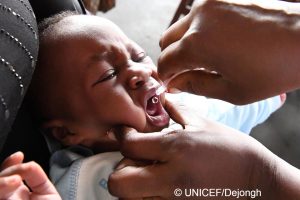Global vaccination rates stagnant due to conflict, inequality and complacency
– 8% of babies born in Ireland in 2018 were not vaccinated against measles
– Almost 5,000 Irish infants are unvaccinated against measles
– 76 reported cases of measles in Ireland in 2018

For photos and broll, please click here. For the 2018 data, click here.
DUBLIN / NEW YORK/GENEVA, 15 July 2019 – 20 million children worldwide – more than 1 in 10 – missed out on lifesaving vaccines such as measles, diphtheria and tetanus in 2018, according to new data from WHO and UNICEF.
Globally, since 2010, vaccination coverage with three doses of diphtheria, tetanus and pertussis (DTP3) and one dose of the measles vaccine has stalled at around 86 percent. While high, this is not sufficiently high. 95 percent coverage is needed – globally, across countries, and communities – to protect against outbreaks of vaccine-preventable diseases.
In Ireland, where 5,000 infants born in 2018 were not vaccinated, there were 76 reported cases of measles. Overall, 92% of babies born in Ireland last year got their first measles vaccine, meaning 8% did not. Though this represents only a small decrease from previous years it leaves Irish children at risk. Measles vaccination rates in Ireland hit a high of 93% in the years 2013 – 2015 but have never reached the target levels of 95% and above.
“Vaccines are one of our most important tools for preventing outbreaks and keeping the world safe,” said Dr Tedros Adhanom Ghebreyesus, Director-General of the World Health Organization. “While most children today are being vaccinated, far too many are left behind. Unacceptably, it’s often those who are most at risk– the poorest, the most marginalized, those touched by conflict or forced from their homes – who are persistently missed.”
Most unvaccinated children live in the poorest countries and are disproportionately found in fragile or conflict-affected states. Almost half are in just 16 countries – Afghanistan, the Central African Republic, Chad, Democratic Republic of the Congo (DRC), Ethiopia, Haiti, Iraq, Mali, Niger, Nigeria, Pakistan, Somalia, South Sudan, Sudan, Syria and Yemen. If these children do get sick, they are at risk of the severest health consequences, and least likely to access lifesaving treatment and care.
Measles outbreaks reveal entrenched gaps in coverage, often over many years.
Stark disparities in access to vaccines persist across and within countries of all income levels. This has resulted in devastating measles outbreaks in many parts of the world – including countries that have high overall vaccination rates.
In 2018, almost 350,000 measles cases were reported globally, more than doubling from 2017.
“Measles is a real time indicator of where we have more work to do to fight preventable diseases,” said Henrietta Fore, UNICEF’s Executive Director. “Because measles is so contagious, an outbreak points to communities that are missing out on vaccines due to access, costs or, in some places, complacency. We have to exhaust every effort to immunize every child.”
Ukraine leads a varied list of countries with the highest reported incidence rate of measles in 2018. While the country has now managed to vaccinate over 90 percent of its infants, coverage had been low for several years, leaving a large number of older children and adults at risk.
Several other countries with high incidence and high coverage have significant groups of people who have missed the measles vaccines in the past. This shows how low coverage over time or discrete communities of unvaccinated people can spark deadly outbreaks.
Human papillomavirus (HPV) vaccine coverage data available for the first time
For the first time, there is also data on the coverage of human papillomavirus (HPV) vaccine, which protects girls against cervical cancer later in life. As of 2018, 90 countries – home to 1 in 3 girls worldwide – had introduced the HPV vaccine into their national programmes. Just 13 of these are lower-income countries. This leaves those most at risk of the devastating impacts of cervical cancer still least likely to have access to the vaccine.
Together with partners like Gavi, the Vaccine Alliance, WHO and UNICEF are supporting countries to strengthen their immunisation systems and outbreak response, including by vaccinating all children with routine immunisation, conducting emergency campaigns, and training and equipping health workers as an essential part of quality primary healthcare.
######
For photos and broll, please click here. For the 2018 data, click here.
About the data
Since 2000, WHO and UNICEF jointly produce national immunisation coverage estimates for Member States, on an annual basis. In addition to producing the immunisation coverage estimates for 2018, the WHO and UNICEF estimation process revises the entire historical series of immunisation data with the latest available information. The 2018 revision covers 39 years of coverage estimates, from 1980 to 2018. DTP3 coverage is used as an indicator to assess the proportion of children vaccinated and is calculated for children under one year of age. The estimated number of vaccinated children are calculated using population data provided by the 2019 World Population Prospects (WPP) from the UN.
About WHO
The World Health Organization provides global leadership in public health within the United Nations system. Founded in 1948, WHO works with 194 Member States, across six regions and from more than 150 offices, to promote health, keep the world safe and serve the vulnerable. Our goal for 2019-2023 is to ensure that a billion more people have universal health coverage, to protect a billion more people from health emergencies, and provide a further billion people with better health and wellbeing. Visit our website www.who.int.
About UNICEF
UNICEF works in some of the world’s toughest places, to reach the world’s most disadvantaged children. Across more than 190 countries and territories, we work for every child, everywhere, to build a better world for everyone. For more information about UNICEF and its work for children, visit our website.
Follow us on Twitter and Facebook
For more information, please contact:
Aedín Donnelly, Communications and Media Manager for UNICEF Ireland | aedin@unicef.ie | Tel: +353 1 809 0291 | Mob: +353 85 1395272
ENDS
###




